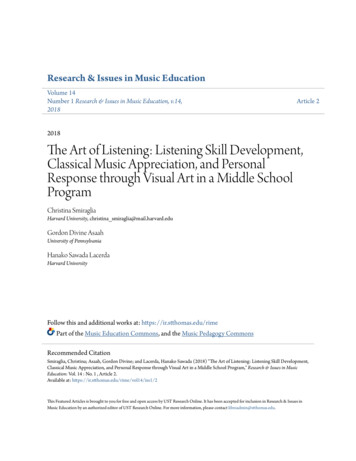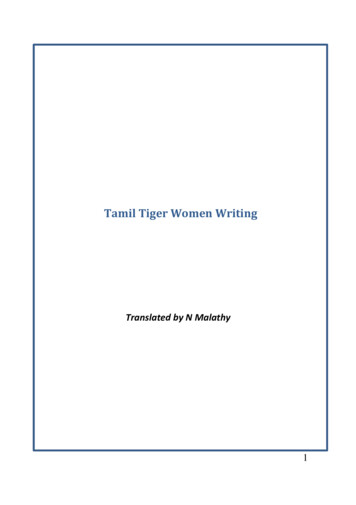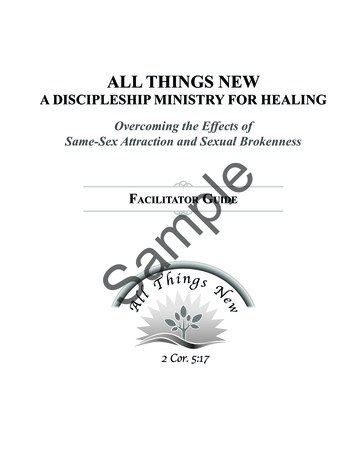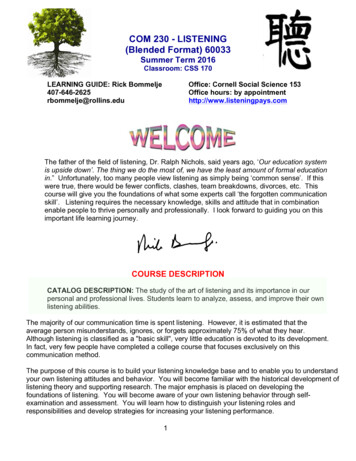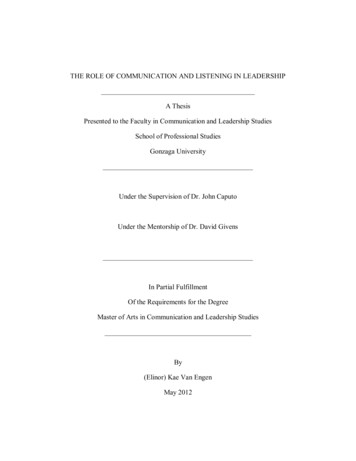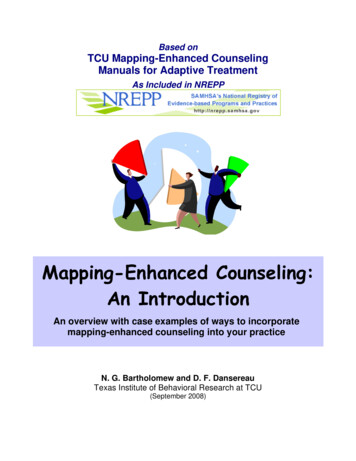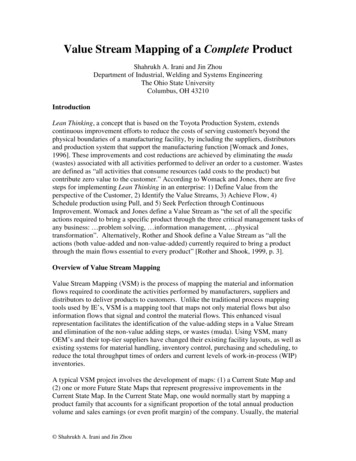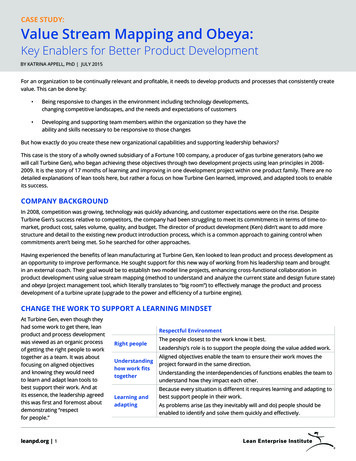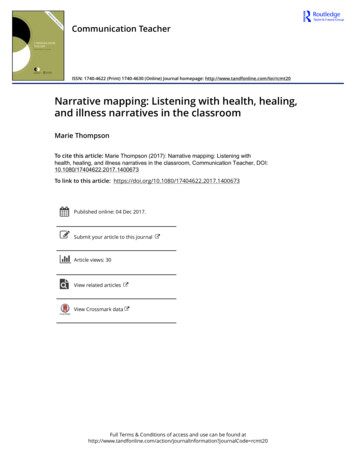
Transcription
Communication TeacherISSN: 1740-4622 (Print) 1740-4630 (Online) Journal homepage: http://www.tandfonline.com/loi/rcmt20Narrative mapping: Listening with health, healing,and illness narratives in the classroomMarie ThompsonTo cite this article: Marie Thompson (2017): Narrative mapping: Listening withhealth, healing, and illness narratives in the classroom, Communication Teacher, DOI:10.1080/17404622.2017.1400673To link to this article: shed online: 04 Dec 2017.Submit your article to this journalArticle views: 30View related articlesView Crossmark dataFull Terms & Conditions of access and use can be found tion?journalCode rcmt20
COMMUNICATION TEACHER, RIGINAL TEACHING IDEA—UNITNarrative mapping: Listening with health, healing, and illnessnarratives in the classroomMarie ThompsonDepartment of Communication, Wright State University, Dayton, USAABSTRACTARTICLE HISTORYDrawing on coursework associated with listening strategies in healthcommunication, students will be guided through a process ofreflection, contemplation and articulation as they map their healthexperience. As visual narrative, maps help to suspend preconceivednotions and/or expectations about health; participants increase thecapacity for a deeper understanding and clearer communicationabout health, the health of others, and course concepts.Courses: Unit activity suited for undergraduate and/or graduateHealth Communication courses.Objectives: Students will increase their proficiency in working withhealth narratives. Students will apply listening strategies to improvetheir communication. Students will develop skills necessary forcommunicating with health professionals.Received 14 September 2016Accepted 26 October 2017Narrative mapping is a form of visual storytelling. In much the same way that cartographers create a story about time, place, and space, narrative mapping invites students tocraft a health narrative in the form of a map by drawing on personal experiences. Exploring health, communication, and narrative, this assignment helps students examinebroader contexts and ideas about healing, illness, and health while also enhancinginter-/intrapersonal listening skills in graduate or undergraduate health communicationcourses. This unit activity should come after discussion about health narratives and strategies for listening to health stories.ObjectivesNarrative mapping involves creativity, various elements of self-reflection, listening dyads,and class discussion—all of which are critical to the process of helping students expandtheir understanding of health. Narrative mapping encourages participants to moveaway from prescriptions of what “should be” (often defined by culture, health industry,and/or media) toward meaning making through contemplation of the experience ofillness and healing.More subtlety, narrative mapping draws participants into listening practices necessaryfor identifying, understanding, and communicating through stories where participants areCONTACT Marie ThompsonMarie.thompson@wright.eduHall, 4630 Colonel Glenn Hwy, Dayton, OH 45435 2017 National Communication AssociationAssociate Professor, Wright State University, 419 Millett
2M. THOMPSONfirst guided in listening to self and then to another’s story. Finally, this assignment isintended to help students develop skills and understanding necessary for increased communication and participation in personal health encounters—skills that can improvehealth outcomes (see Street, Makoul, Arora, & Epstein, 2009).Narrative mapping: Listening to stories mattersHumans are innate storytellers; we make sense of ourselves in and through the storieswe tell. More eloquently, Frank (2012) suggested, “stories are presences that surroundus, call for our attention, offer themselves for adaptation and have a symbioticrelationship with us” (p. 36). “Stories,” he said, “need humans in order to be told,and humans need stories in order to represent experiences that remain inchoateuntil they can be given narrative form” (p. 36). Moreover, our very humanness presupposes our bodies will inevitably experience dis-ease, and that we will attempt tomakes sense of and communicate those shifts in being through stories. Providing students with the opportunity to examine their health narratives can foster a more comprehensive understanding of how narratives function not only as personal, but alsohelp link those experiences and course concepts to broader political, social, and cultural implications of communicating health (see Charon, 2008; Harter, 2012; Sharf,2009).One critical component of understanding a story lies in the ability to implement skillsnecessary for listening to those stories. Speaking to the imperative of attending to patientstories, Charon (2005) pondered how one might “empty the self or at least suspend the selfso as to become a receptive vessel for the language and experience of another” (p. 263). Insharing health narratives through mapping, our empathic capacity for understanding andattending to the particulars of lived human experience is expanded in the visual representation that participants craft and then through which they communicate. For listenersfocused on understanding, listening with the story unfolding through the map assists insuspending preconceived notions and/or expectations about the experience of health.This practice strengthens capacity for deeper understanding and clearer communicationabout our own health while also illuminating broader contexts of health (see Wolvin,2010; Figure 1).Finally, a growing imperative for greater communication, patient responsibility, andparticipation in healthcare necessitates that students develop skills for advocating onbehalf of themselves and/or others. Indeed, Kreps (2001) specifically argued, “providersdepend upon information provided by consumers about idiosyncratic symptoms, ailments, and history of care” (p. 598). Moreover, “interpersonal communication alsois the process consumers and providers use to gather information needed tomonitor treatment and make decisions about refining care strategies over time”(p. 598). Yet, communicating in healthcare environments can be a daunting endeavor,especially for students. While the mapping process draws on narrative and listeningcurriculum, narrative maps are the communicative tools through which participantsarticulate what they have examined, interpreted, and understood about health,healing, and illness. Where maps reveal individual nuances in narratives, greaterclarity emerges for students communicating those particulars with others (see Schoo,Lawn, Rudnick, & Litt, 2015).
COMMUNICATION TEACHER3Figure 1. Healing over time.Framework for practice: Getting startedInstructors will need crayons, markers (not pencils or pens), large paper, (11 17), andapproximately 60–90 minutes to facilitate reflection and allow for sharing in dyads, followed by class discussion. (In shorter class periods, reflection and mapping can be accomplished in one period, dyads and open discussion in another). After explaining theassignment, begin by centering. The centering activity is an instructor-led, guided reflection that promotes focus through relaxed breathing. This will facilitate contemplation ofindividual beliefs, experiences, and expectations surrounding “health.” Students will thenbe guided to identify critical junctures, disruptions in experience, and/or expectations thatmay have interfered with their ideal of health. After the centering exercise, allow for 20–30minutes to create narrative maps. Quiet, calming music assists in minimizing distractionsand encouraging introspection (see Appendix A).When students have finished mapping, they will move on to share their maps in previously self-selected dyads. In dyads, students take turns as both narrators and attentivelisteners of another’s lived experience. Applying intentional and supportive listening strategies, students are directed to “seek to understand” from the narrator’s perspective, waitthrough silences, and refrain from interrupting while the speaker is sharing. Once thespeaker has finished, listeners use paraphrasing strategies as a means of clarifying andunderstanding the speaker’s intent. These directives emphasize listening for meaningboth intrapersonally and interpersonally as students seek to understand, articulate, andattend, first, to their lived experience and, second, in striving to understand another.Letting students’ insights and experiences guide the process, instructors will extenddebriefing and reflection during the open class discussion by asking what was intriguingand/or challenging about the process of, and stories that emerged from, narrativemapping. Here, a keener examination of the lived experience helps instructors guide,
4M. THOMPSONexplore, and expand various course concepts and diverse contexts in health communication. In the culmination of understanding their own stories, listening to others, and consciously linking curriculum beyond the classroom, instructors will find that, throughnarrative mapping, students accrue insight, language, and necessary tools for understanding and communicating anew in health environments. In these ways, students gain confidence communicating as well as connecting and implementing critical intra-/interpersonal communicative skills through narrative mapping.Engaging praxis through debriefingDebriefing begins in listening dyads between students where teachers instruct listeningfor meaning (intra- and interpersonal) and the use of paraphrasing for clarity andunderstanding. Students often express a myriad of feelings and insights both in dyadsand open class forum. These insights guide discussion and debriefing about the experience of narrative mapping. Because each narrative map is a unique representation ofthat individual’s perception and experience, it is both plausible and acceptable thatobservers may not initially “understand” the map. Importantly, the map is the communicative tool through which one articulates the lived experience. Students share what isimportant to them; instructors help to bridge emergent themes to broader healthcontexts.Often, unanticipated epiphanies emerge through narrative mapping. For instance, aftermapping her family’s journey through a parent’s diagnosis and treatment of diabetes, onestudent reflected on both challenges and shifts in the entire familial dynamics. Having previously shared elements of her experience, narrative mapping provided deeper insight intothe impact diabetes had on her, her family’s life, and their communication. As a class, weextended the conversation to compare her experience to media messages about diabetesand then linked those constructs to frames of narrative identity (see Brown and Addington-Hall’s [2008] sustaining, enduring, preserving, and fracturing narratives; Frank’s[1995] restitution, chaos, and quest narratives; and Geist & Gates’ [1996] biology to biography; Figure 2).Paradox, potential, and limitationsThe greatest challenge of this exercise rests with the very opportunity to communicateanew. Paradoxically, students sometimes feel constrained by such freedom. Some willwant and “need” to know exactly what to put on their map, even as they are encouragedto map unconditionally. It is not uncommon for some participants to feel artisticallyinadequate, fearful of judgment, or to express powerlessness in the face of potential.Quiet background music increases relaxation, helping to reduce apprehension anddoubt. Encouraging students to listen to and trust themselves as their stories emerge isalso a helpful reminder; they must refrain from self-criticism. Time and patience duringreflection generally eases this initial angst.Instructors with limited time could conduct the centering activity and begin mappingin class. Unfinished maps could be completed at participants’ ease, and dyads could alsomeet outside of class, leaving students more time for discussion, debriefing, and reflection.Where debriefing continues in follow-up class discussion, instructors will help students
COMMUNICATION TEACHER5Figure 2. Making it through diabetes.make connections between course materials, larger cultural narratives, and students’ livedexperiences. To help protect against vulnerabilities or exploitation of students’ stories,instructors must actively and sensitively help maintain a balance between sharing and“sharing too much.”Other possibilities include creating mock interviews where, using the narrative maps, students could focus on and develop specific skill sets (i.e. motivational interviewing, perception,and representation). Students could share narrative maps with family members, further practicing skills necessary for communicating with health providers. The narrative map is thecritical component for keeping the patients’ story central to communicative endeavors andattempts to understand the lived/living experience of health, healing, and illness. Narrativemapping assists students in constructing language and strategies to communicate theirneeds better and to work to improve healthcare for themselves and others.ReferencesBrown, J., & Addington-Hall, J. (2008). How people with motor Neurone disease talk about livingwith their illness: A narrative study. Journal of Advanced Nursing, 62(2), 200–208.Charon, R. (2005). Narrative medicine: Attention, representation, affiliation. Narrative, 13(3), 261–270. Retrieved from https://ohiostatepress.org/Narrative.htmlCharon, R. (2008). Honoring the stories of illness. Oxford, NY: Oxford University Press.Frank, A. W. (1995). The wounded storyteller: Body, illness and ethics. London: University ofChicago Press.Frank, A. W. (2012). Practicing dialogic narrative analysis. In J. A. Holstein and J. F. Gubrium(Eds.) Varieties of narrative analysis (pp. 33–52). Thousand Oaks, CA: Sage.Geist, P., & Gates, L. (1996). The poetics and politics of re-covering identities in health communication. Communication Studies, 47, 218–228. Retrieved from http://www.tandfonline.com/toc/rcst20/current
6M. THOMPSONHarter, L. M. (2012). Imagining new normals: A narrative framework for health communication.Dubuque, IA: Kendall Hunt.Kreps, G. L. (2001). Consumer/provider communication research: A personal plea to address issuesof ecological validity, relational development, message diversity and situational constraints.Journal of Health Psychology, 6(5), 597–601.Schoo, A. M., Lawn, S., Rudnick, E., & Litt, J. C. (2015). Teaching health science students foundation motivational interviewing skills: Use of motivational interviewing treatment integrityand self-reflection to approach transformative learning. BMC Medical Education, 15, 1–11.Sharf, B. F. (2009). Observations from the outside in: Narratives of illness, healing and mortality ineveryday life. Journal of Applied Communication Research, 37(2), 132–139.Street, R. L., Makoul, G., Arora, N. K., & Epstein, R. M. (2009). How does communication heal?Pathways linking patient communication to health outcomes. Patient Education andCounseling, 74, 295–301.Wolvin, A. D. (2010). Listening and human communication in the 21st century. West Sussex: WileyBlackwell.Appendix A: Narrative mapping in the classroom—instructor directionsand preparation for reflection and sharingReview previous lessons regarding health narratives and listening strategies. Before reflection exercise, hand out paper, crayons, and markers so students are prepared to move from reflectiondirectly into mapping. Allow 10–15 minutes for reflection and 15–30 minutes for mapping.Have students preselect dyads for sharing their maps.Enhancing student reflection.Begin by creating a relaxing atmosphere.Minimize bright lights. Use soothing background music.Read slowly. Be heard; invite introspection. Pause between questions. Explore experience, attitudes, values, and beliefs.Have students breath in through the nose, exhaling through the mouth. If they are comfortabledoing so, close eyes. .Directions to studentsDrawing on the power of stories and the importance of attentive listening, you will be contemplating health and creating a narrative map. Through a series of questions, you will contemplate whathealth, healing, and illness mean to you, from your experience. Let questions guide your curiosityabout health; not every question will resonate with you. There is no single right way to create a map.Ultimately, you will use your map to share your narrative and to help others understand what yourexperience means to you.Guided reflectionIn preparation for contemplation, begin relaxed breathing (in through the nose, out through themouth).[Pause]Think about your health.What does health mean to you? What is healing? What does it entail?
COMMUNICATION TEACHER7When you think about your physical and/or mental health, what do you envision?How do you know you are experiencing this state of being? Where in your body do you sensethis?[Pause]If you have encountered an experience that has separated you from that vision of health, thinkabout that now. Do you have an ongoing health issue? Have you been recently diagnosed with anillness disease injury or reoccurrence? Has someone close to you experienced a crisis orshift in health?[Pause]A map is both a guide and a story. Maps depict landscapes and reveal landmarks, barriers, andbridges. Maps describe isolated territories, where people gather or where the sun rises and sets. Likestories, maps help us make sense of where—and who—we are, providing details about a particularplace or journey [Pause] (for instance, there is only one route across this river—you have to gothis way). Often, particular landmarks mark a specific part of the journey. We know we are herewhen .(is there a specific feeling, sense of something person/people) are present, we arealmost to this place when (what is present? missing? .Whose voices are heard, or maybemissing?) [Pause]If you were going to map your story where would you begin—where would you enter the conversation today? Take some time now, with paper, markers, and crayons to begin to map yourjourney. Identify what seems most important to you. Work until you feel satisfied with your story.Know that you can return to the map at any time. This is your story, your map, your experience.Dyads: Sharing our story.Review listening strategies (open-ended questions, paraphrasing, no interrupting).e.g. “Can you say more about this part?” or “Did anything surprise you?”Allow for contemplation and silence.Students take turns being listener and narrator. Speaker focuses on telling the story and sharingkey insights; listener seeks to understand.First/last questions: “Is there anything else you want to say?” “Is there anything else you wantme to understand?” .
phers create a story about time, place, and space, narrative mapping invites students to craft a health narrative in the form of a map by drawing on personal experiences. Explor-ing health, communication, and narrative, this assignment helps students examine broader contexts and ideas about healing, illness, and health while also enhancing

